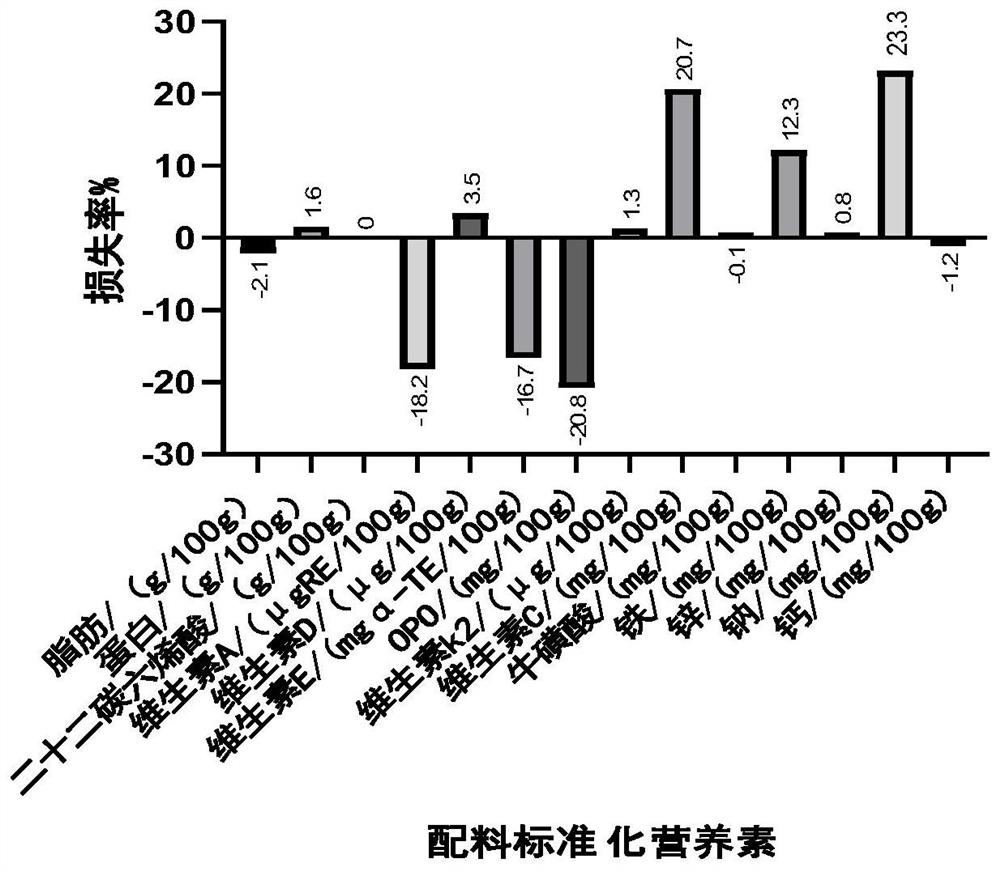Milk powder for children and preparation method thereof
A milk powder and children's technology, applied in dairy products, whey, applications, etc., can solve problems such as insufficient nutrient intake, affecting children's growth and development, and insufficient nutrients in children's formula milk powder, and achieve the effect of promoting physical development
- Summary
- Abstract
- Description
- Claims
- Application Information
AI Technical Summary
Problems solved by technology
Method used
Image
Examples
Embodiment 1
[0046] The design of embodiment 1 basic formula
[0047] 1. Determine the content of macronutrients, amino acids, vitamins, minerals and fatty acids in the raw and auxiliary materials used in the production of children's milk powder to establish an amino acid model, see Table 1-5.
[0048] Table 1 Macronutrient content of raw materials
[0049]
[0050] Table 2 Amino acid content and pattern of raw and auxiliary materials
[0051]
[0052] Table 3 Vitamin content of raw and auxiliary materials
[0053]
[0054] Table 4 Mineral content of raw and auxiliary materials
[0055]
[0056] Table 5 Fat and fatty acid content of raw materials
[0057]
[0058] 2. Inquire about the macronutrients, amino acids, fatty acids, vitamins and minerals requirements of children aged 3-6 in the Reference Intake Guidelines for Dietary Nutrients for Chinese Residents, see Table 6-10 for details.
[0059] Table 6 Recommended intake of macronutrients for children aged 3-6 years (g / ...
Embodiment 2
[0073] Embodiment 2 The preparation method of children's formula milk powder
[0074] The children's milk powder is prepared according to parts by weight: 15-20 parts of raw cow milk, 40-45 parts of skimmed milk powder, 10-15 parts of whey powder, 2-3 parts of whey protein powder, 8-10 parts of syrup, 3.5-4.5 parts of fructooligosaccharides, 2-3 parts of galactooligosaccharides, 10-12 parts of vegetable oil, 0.2-0.3 parts of docosahexaenoic acid, 1-2 parts of calcium carbonate, 0.1-0.2 parts of vitamin premix package , Mineral premix package 0.1-0.2 servings.
[0075] Further, this children's milk powder, in parts by weight, comprises the following components (ton yield): 15-20 parts of raw cow milk, 40-45 parts of skimmed milk powder, 10-15 parts of demineralized whey powder, 2- 3 parts, 8-9 parts of solid corn syrup, 3.5-4.5 parts of fructooligosaccharides, 2-3 parts of galactooligosaccharides, 0.2-0.3 parts of docosahexaenoic acid (DHA), edible vegetable blend oil (contain...
Embodiment 3
[0102] Example 3 Nutrient loss changes during processing
[0103] 1. Loss of nutrients in the batching stage
[0104] After batching, the nutrients of the mixed material were tested, and the loss rate was calculated. The results are shown in Table 12.
[0105] Table 12 Content of each component in the mixed material
[0106]
[0107]
[0108] According to Table 12, the average value of the loss rate of nutrients in the batching stage is obtained. For details, see figure 2 . Among them, vitamin C, mineral iron, and mineral sodium are the most lost, and their average loss rates are 20.7%, 12.4%, and 23.3%, respectively.
[0109] 2. Loss of nutrients in the sterilization and concentration stages
[0110] After the mixture was sterilized and concentrated, the content of each nutrient in it was detected, and the corresponding loss rate was calculated. The results are shown in Table 13.
[0111] Table 13 Content of each component in the mixed material after sterilization...
PUM
 Login to View More
Login to View More Abstract
Description
Claims
Application Information
 Login to View More
Login to View More - R&D
- Intellectual Property
- Life Sciences
- Materials
- Tech Scout
- Unparalleled Data Quality
- Higher Quality Content
- 60% Fewer Hallucinations
Browse by: Latest US Patents, China's latest patents, Technical Efficacy Thesaurus, Application Domain, Technology Topic, Popular Technical Reports.
© 2025 PatSnap. All rights reserved.Legal|Privacy policy|Modern Slavery Act Transparency Statement|Sitemap|About US| Contact US: help@patsnap.com



